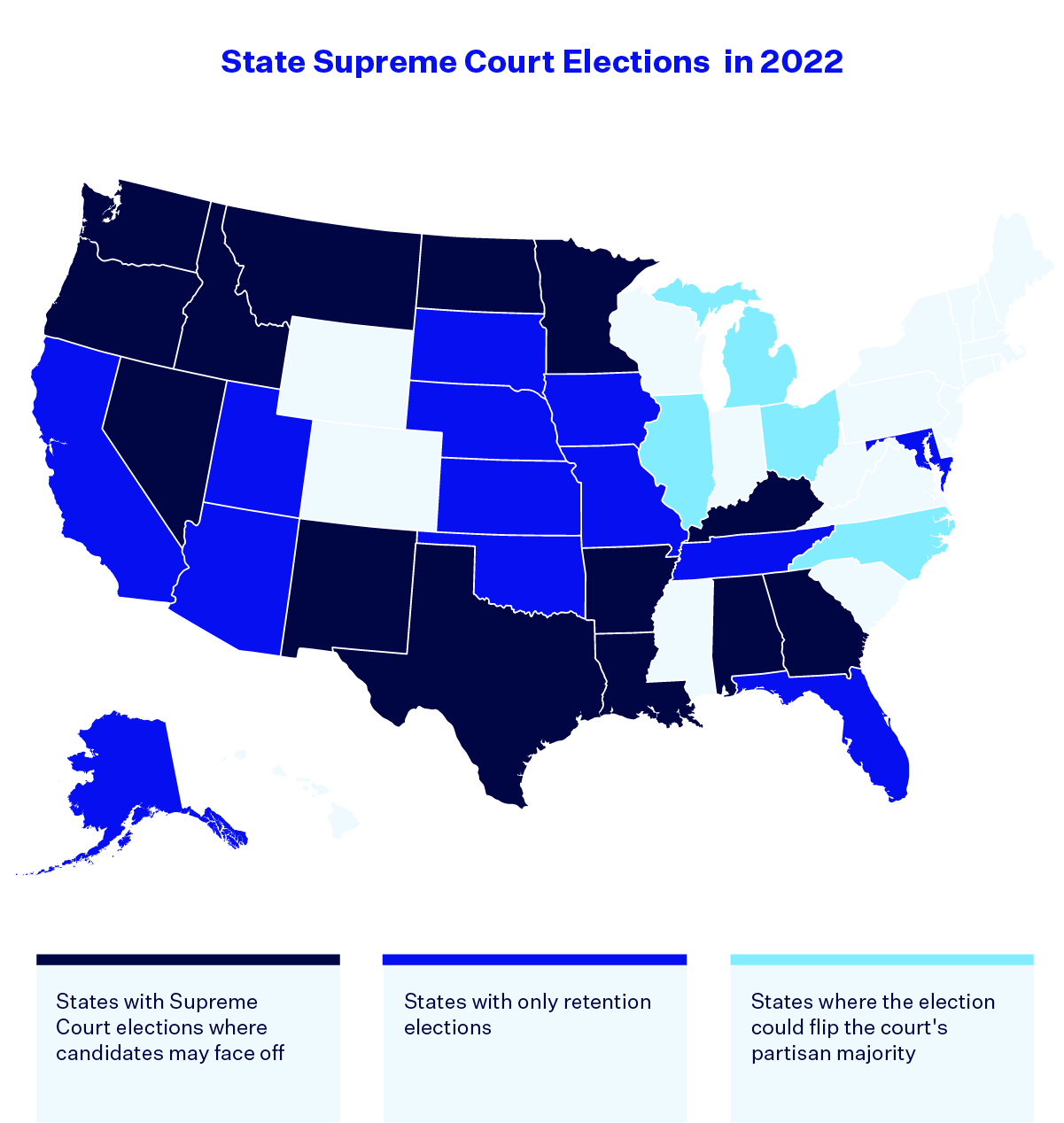The State Supreme Court Races We’re Watching This Year

While most attention this fall will be on elections to the U.S. House of Representatives and U.S. Senate, there are plenty of important elections happening further down the ballot. Voters in several states won’t just be electing legislators and governors — they’ll also vote on state Supreme Court justices. In today’s piece, we’re highlighting the state Supreme Court races we’ll be paying close attention to on Nov. 8.
More than 30 states have state Supreme Court elections this year.

This November, voters in 31 states will have state Supreme Court justices on their ballots. In 18 of these states, voters will directly select their state court’s next justice, with the candidates listed on the ballot for voters to choose from. In the other 13 states, voters will take part in a retention election — a yes-or-no vote on whether the incumbent justice deserves to stay on the court for another term. It’s quite rare for judges to lose retention elections, and even if they do, a replacement judge is usually appointed by the governor, so in these states, the outcome of the gubernatorial contest will have a greater influence on the court’s composition. While all of these races will influence legal outcomes in their respective states, there are only four states where the elections could tip partisan control of the court.
Here are the states where partisan control of the courts is on the line.
Illinois
Current partisan composition: four Democrats and three Republicans
Even though Illinois is a solidly Democratic state, this year Republicans have a chance to flip partisan control of the state Supreme Court with two elections for open seats — one of which opened up in 2020 when an incumbent Democratic justice became the first to lose a retention vote in the state’s history. Republicans will need to win both races to gain a majority.
Unlike most states, Illinois elects state Supreme Court justices by district, which the state redrew last year for the first time in 60 years. The state is divided into five districts, with the 1st District electing three justices and the other four districts each electing one. In the 2nd District, three Democrats and two Republicans are running in the June primary, and the winning candidates from each party will face off in November. In the 3rd District, Mary O’Brien (D), an Illinois Appellate Court judge, is running against Michael Burke (R), the incumbent Supreme Court justice for the 2nd District whose home was redrawn into the 3rd during redistricting. Complicating matters for Democrats is that neither the 2nd District nor the 3rd contain any portion of Cook County, the state’s most populous and a Democratic stronghold.
Michigan
Current partisan composition: four Democrats and three Republicans
Two Michigan Supreme Court justices are running for re-election this year: Richard Bernstein (D) and Brian Zahra (R). Supreme Court races in Michigan are unique — while candidates can be nominated by political parties, the November election itself is nonpartisan, meaning that the two candidates with the most votes win, regardless of their partisan affiliation. If Republicans re-elect Zahra and another Republican to replace Bernstein, the party will gain control of the court.
The Michigan Democratic Party endorsed Bernstein for re-election, as well as state Rep. Kyra Harris Bolden (D) for the seat held by Zahra. The Michigan Republican Party endorsed Zahra for re-election and lawyer Paul Hudson (R) for the seat held by Bernstein. Other nonpartisan candidates could also appear on the ballot.
The outcome of Michigan’s Supreme Court elections could have implications for the 2024 presidential election, as allies of Trump work to take over election administration in the state. In 2020, the state Supreme Court refused to hear a challenge to the state’s election results. A Republican-controlled court may not make the same decision.
North Carolina
Current partisan composition: four Democrats and three Republicans
In North Carolina, the state Supreme Court has been an important bulwark against the state’s Republican-controlled Legislature, overturning extreme partisan gerrymanders and blocking laws designed to reduce the power of the state’s Democratic governor. Two seats held by Democrats are up for election this year, and if Republicans win just one of them, control of the court will flip.
Justice Robin Hudson (D) is retiring since she will reach the mandatory retirement age next year. Lucy Inman (D), a judge on the North Carolina Court of Appeals, the state’s intermediate appellate court, is running to replace her. She’ll face Richard Dietz (R), a fellow Court of Appeals judge this November. In North Carolina’s other race, Justice Sam J. Ervin IV (D) is running for reelection to his second term on the court. He is being challenged by Trey Allen (R), a law professor at UNC-Chapel Hill.
Similar to Michigan, the outcome of these races could have huge implications for gerrymandering and voting rights in North Carolina. Both Ervin and Hudson were in the majority that struck down Republican gerrymanders this year. After this year’s elections, the North Carolina legislature will have another opportunity to draw a gerrymandered congressional map — and if just one of them is replaced by a Republican, the state Supreme Court could let them get away with it. The court is also hearing a case related to felony disenfranchisement that could be impacted by the election outcomes if no decision is reached by the end of the year.
Ohio
Current partisan composition: four Republicans and three Democrats
There are three Republican-held Supreme Court seats on the ballot in Ohio, including one left open by Chief Justice Maureen O’Connor’s (R) retirement. The three elections give Democrats a chance of winning a majority of the court — despite the state’s Republican trend, a Democrat won a state Supreme Court race as recently as 2020 and could win the majority by winning just one of these races. Unfortunately, Republicans have made state Supreme Court elections in Ohio partisan in an attempt to stave off this possibility.
Incumbent justices Jennifer Brunner (D) and Sharon Kennedy (R) are facing off for the chief justice position. If Brunner wins, but Gov. Mike DeWine (R) also wins re-election, he could appoint a Republican to replace her as associate justice, so to secure a majority, Democrats would also need to win one of the other two seats on the ballot. Incumbent Justice Pat Fischer (R) will face Court of Appeal Judge Terri Jamison (D) and incumbent Justice Pat DeWine (R) (son of Gov. DeWine) is up against Court of Appeals Judge Marilyn Zayas (D).
With O’Connor retiring, the election outcomes — like in North Carolina — will decide the future of partisan gerrymandering litigation. O’Connor has joined the court’s Democrats in a series of rulings against extreme Republican gerrymanders. Kennedy, the Republican running to replace her, voted to uphold the gerrymanders, so if Democrats fail to win any of the races, the court may not stop future partisan gerrymanders in Ohio.
Democracy will be on the ballot in several states.
Republican judges in the states have shown over and over again that they are hostile to attempts to rein in partisan gerrymandering, receptive to fraudulent arguments about voter fraud and reluctant to block discriminatory voting or disenfranchisement laws. Unfortunately, that means partisan control is not just on the ballot in state Supreme Courts in Illinois, Michigan, North Carolina and Ohio. Democracy is on it as well.